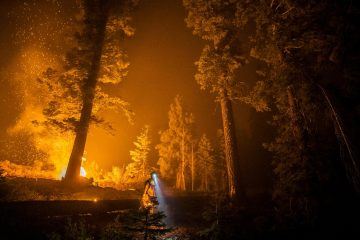David Helvarg in National Geographic:
 It was a comfortable looking home in a high-risk location, on Stringtown Road in the wooded hills south of Lake Oroville—a brown wood house with a stone chimney and big picture windows facing the forest. The pleasantly cluttered garden had tomato plants, a glass flamingo, and an abalone shell. It was here that a CAL FIRE task force, including a couple of engines and a dozen firefighters, decided to take a stand. They’d been pushed around by the Bear Fire for 24 hours. They would try to save at least one house.
It was a comfortable looking home in a high-risk location, on Stringtown Road in the wooded hills south of Lake Oroville—a brown wood house with a stone chimney and big picture windows facing the forest. The pleasantly cluttered garden had tomato plants, a glass flamingo, and an abalone shell. It was here that a CAL FIRE task force, including a couple of engines and a dozen firefighters, decided to take a stand. They’d been pushed around by the Bear Fire for 24 hours. They would try to save at least one house.
Before passing through a police roadblock to meet the firefighters, I’d been to the rapidly growing CAL FIRE base camp at the fairgrounds in Chico. Like all CAL FIRE camps, it now requires passing through a “Mass Fever Screening” tent for COVID-19. Wearing a mask in California today, during a pandemic and a record-shattering fire season, serves a dual purpose. For days parts of this state have been competing with smoke-choked places in Oregon and Washington for the worst air quality in the world.
When I reached Oroville on September 9, the Bear Fire, the deadliest so far in 2020, had exploded in the hills north of the lake. Part of the North Complex fire, it had grown to 1,000 acres in its first half hour and advanced 30 miles in 18 hours. A wall of flame had destroyed the town of Berry Creek, including its fire station and fire truck—a grim reminder of the catastrophe that struck Paradise, California, just 14 miles to the northwest, in 2018.
More here.
